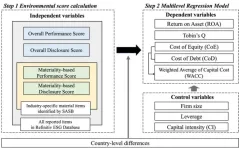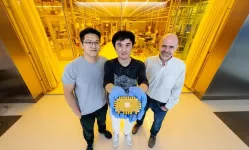(Press-News.org) It wasn’t that long ago when cigarettes and soda were go-to convenience store vices, glamorized in movies and marketed toward, well, everyone.
Then, lawmakers and voters raised taxes on cigarettes, and millions of dollars went into public education campaigns about smoking’s harms. Decades of news coverage chronicled how addictive and dangerous cigarettes were and the enormous steps companies took to hide the risks and hook more users. The result: a radical shift in social norms that made it less acceptable to smoke and pushed cigarette use to historic lows, especially among minors.
New UC Berkeley research suggests sugar-sweetened beverages may be on a similar path.
The city of Berkeley’s first-in-the-nation soda tax a decade ago, along with more recent Bay Area tax increases on sugar-sweetened drinks, have not only led to reduced sales. They are also associated with significant changes in social norms and attitudes about the healthfulness of sweet drinks, said Kristine A. Madsen, a professor at UC Berkeley’s School of Public Health and senior author of a paper published Nov. 25 in the journal BMC Public Health.
Over the span of just a few years, taxes coupled with significant media attention significantly affected the public’s overall perceptions of sugar-sweetened beverages, which include sodas, some juices and sports drinks. Such a shift in the informal rules surrounding how people think and act could have major implications for public health efforts more broadly, Madsen said.
“Social norms are really powerful. The significant shift we saw in how people are thinking about sugary drinks demonstrates what else we could do,” Madsen said. “We could reimagine a healthier food system. It starts with people thinking, ‘Why drink so much soda?’ But what if we also said, ‘Why isn’t most of the food in our grocery stores food that makes us healthy?'”
Madsen and colleagues from UC San Francisco and UC Davis analyzed surveys from 9,128 people living in lower-income neighborhoods in Berkeley, Oakland, San Francisco and Richmond. Using data from 2016 to 2019 and 2021, they studied year-to-year trends in people’s perception of sugar-sweetened beverages.
They wanted to understand how the four taxes in the Bay Area might have affected social norms surrounding sugary beverages — the unwritten and often unspoken rules that influence the food and drinks we buy, the clothes we wear and our habits at the dinner table. Although social norms aren’t visible, they are incredibly powerful forces on our actions and behaviors; just ask anyone who has bought something after an influencer promoted it on TikTok or Instagram.
Researchers asked questions about how often people thought their neighbors drank sodas, sports drinks and fruity beverages. Participants also rated how healthy several drinks were, which conveyed their own attitudes about the beverages.
The researchers found a 28% decline in the social acceptability of drinking sugar-sweetened beverages.
In Oakland, positive perceptions of peers’ consumption of sports drinks declined after the tax increase, relative to other cities. Similarly, in San Francisco, attitudes about the healthfulness of sugar-sweetened fruit drinks also declined.
In other words, people believed their neighbors weren’t drinking as many sugar-sweetened beverages, which affected their own interest in consuming soda, juices and sports drinks.
“What it means when social norms change is that people say, ‘Gosh, I guess we don’t drink soda. That’s just not what we do. Not as much. Not all the time,’” Madsen said. “And that’s an amazing shift in mindsets.”
The research is the latest from UC Berkeley that examines how consumption patterns have changed in the decade since Berkeley implemented the nation’s first soda tax. A 2016 study found a decrease in soda consumption and an increase in people turning to water. Research in 2019 documented a sharp decline in people turning to sugar-sweetened drinks. And earlier this year, Berkeley researchers documented that sugar-sweetened beverage purchases declined dramatically and steadily across five major American cities after taxes were put in place.
The penny-per-ounce tax on beverages, which is levied on distributors of sugary drinks — who ultimately pass that cost of doing business on to consumers — is an important means of communicating about health with the public, Madsen said. Researchers tallied more than 700 media stories about the taxes on sugar-sweetened beverages during the study period. That level of messaging was likely a major force in driving public awareness and norms.
It’s also something Madsen said future public health interventions must consider. It was part of the progress made in cutting cigarette smoking and seems to be working with sugary drinks. And it’s those interventions that can lead to individual action.
“If we change our behaviors, the environment follows,” Madsen said. “While policy really matters and is incredibly important, we as individuals have to advocate for a healthier food system.”
END
Soda taxes don’t just affect sales. They help change people’s minds.
UC Berkeley researchers found that taxes on sugar-sweetened beverages, coupled with media attention, coincided with significant changes in social norms around sugary drinks.
2024-12-10
ELSE PRESS RELEASES FROM THIS DATE:
Early restrictive vs liberal oxygen for trauma patients
2024-12-10
About The Study: In adult trauma patients, an early restrictive oxygen strategy compared with a liberal oxygen strategy initiated in the prehospital setting or on trauma center admission for 8 hours did not significantly reduce death and/or major respiratory complications within 30 days.
Corresponding Author: To contact the corresponding author, Jacob Steinmetz, MD, PhD, email jacob.steinmetz@regionh.dk.
To access the embargoed study: Visit our For The Media website at this link https://media.jamanetwork.com/
(doi:10.1001/jama.2024.25786)
Editor’s Note: Please see the article for additional information, ...
Enabling AI to explain its predictions in plain language
2024-12-10
CAMBRIDGE, MA – Machine-learning models can make mistakes and be difficult to use, so scientists have developed explanation methods to help users understand when and how they should trust a model’s predictions.
These explanations are often complex, however, perhaps containing information about hundreds of model features. And they are sometimes presented as multifaceted visualizations that can be difficult for users who lack machine-learning expertise to fully comprehend.
To help people make sense of AI explanations, MIT researchers used large language models (LLMs) to transform plot-based explanations into plain language.
They developed ...
A greener, cleaner way to extract cobalt from ‘junk’ materials
2024-12-10
Siddarth Kara’s bestseller, “Cobalt Red: How the Blood of Congo Powers Our Lives,” focuses on problems surrounding the sourcing of cobalt, a critical component of lithium-ion batteries that power many technologies central to modern life, from mobile phones and pacemakers to electric vehicles.
“Perhaps many of us have read how lithium-ion batteries are vital for energy storage technologies,” says Eric Schelter, the Hirschmann-Makineni Professor of Chemistry at the University of Pennsylvania. “But how material that make up such batteries are sourced can be concerning and problematic, both ethically and environmentally.”
Schelter ...
Better environmental performance boosts profits and cuts costs
2024-12-10
Fukuoka, Japan—Sustainable practices in business are more than just an ethical responsibility; they make sound financial sense. Researchers from Kyushu University, in a study published on December 10, 2024, in Corporate Social Responsibility and Environmental Management, reveal that companies with better environmental performance and transparent disclosures can lower costs and boost profits.
Investors are increasingly recognizing companies' contributions toward carbon neutrality, driving the growth of environmental, social, and governance (ESG) investing. To support this trend, the Sustainability Accounting Standards Board (SASB) has provided an industry-specific framework ...
Making self-driving cars safer, less accident prone
2024-12-10
Self-driving cars rely on artificial intelligence to predict where nearby cars will go. But when those predictions don’t match reality, that discrepancy can potentially lead to crashes and less safe roadways.
That’s why a recent study from the University of Georgia developed a new AI model to make self-driving cars safer.
This study introduces an AI model for self-driving cars, designed to predict the movement of nearby traffic and incorporate innovative features for planning safe vehicle movements.
"The planned trajectory of the self-driving car may turn out to collide with the actual trajectory of another vehicle.” —Qianwen Li, College ...
Rethinking the quantum chip
2024-12-10
Researchers at the UChicago Pritzker School of Molecular Engineering (UChicago PME) have realized a new design for a superconducting quantum processor, aiming at a potential architecture for the large-scale, durable devices the quantum revolution demands.
Unlike the typical quantum chip design that lays the information-processing qubits onto a 2-D grid, the team from the Cleland Lab has designed a modular quantum processor comprising a reconfigurable router as a central hub. This enables any two qubits to connect and entangle, where in the ...
When does waiting stop being worth it?
2024-12-10
You’re standing at a bus stop, waiting for a ride that seems like it will never come. At first, you’re hopeful that it will be here any second. But as the minutes laggardly drag on, doubt creeps in. Should you keep waiting, or is it smarter to start walking or call for a ride?
“It’s a classic dilemma. “Do you persist with the belief that the bus is on its way, or do you cut your losses and move on to something else?” asks Joe Kable, a psychologist in the School of Arts ...
Nationwide study looks at when and where EV owners use public charging stations
2024-12-10
AUSTIN, TX, Dec 10, 2024 – Electric Vehicles (EVs) represent a promising mode of transportation that can help the United States reduce its carbon emissions. But barriers such as the high cost of installing and using EV Charging Stations (EVCS), their limitations in supplying emerging demand, and their uneven distribution throughout the country limit access for many Americans.
Researchers at the University of Maryland are using supercomputers and machine learning methods to analyze a full year of real-time data collected from individual EV charging ports at more than 50,000 publicly available stations throughout the country. The primary focus of the study is ...
A new discovery about the source of the vast energy in cosmic rays
2024-12-10
Ultra-high energy cosmic rays, which emerge in extreme astrophysical environments—like the roiling environments near black holes and neutron stars—have far more energy than the energetic particles that emerge from our sun. In fact, the particles that make up these streams of energy have around 10 million times the energy of particles accelerated in the most extreme particle environment on earth, the human-made Large Hadron Collider.
Where does all that energy come from? For many years, scientists believed it came from ...
Cancer ‘fingerprint’ can improve early detection
2024-12-10
Different types of cancer have unique molecular ‘fingerprints’ which are detectable in early stages of the disease and can be picked up with near-perfect accuracy by small, portable scanners in just a few hours, according to a study published today in the journal Molecular Cell.
The discovery by researchers at the Centre for Genomic Regulation (CRG) in Barcelona sets the foundation for creating new, non-invasive diagnostic tests that detect different types of cancer faster and earlier than currently possible.
The study centres around the ribosome, the protein factories of a cell. For decades, ribosomes were thought ...
LAST 30 PRESS RELEASES:
Numbers in our sights affect how we perceive space
SIMJ announces global collaborative book project in commemoration of its 75th anniversary
Air pollution exposure and birth weight
Obstructive sleep apnea risk and mental health conditions among older adults
How talking slows eye movements behind the wheel
The Ceramic Society of Japan’s Oxoate Ceramics Research Association launches new international book project
Heart-brain connection: international study reveals the role of the vagus nerve in keeping the heart young
Researchers identify Rb1 as a predictive biomarker for a new therapeutic strategy in some breast cancers
Survey reveals ethical gaps slowing AI adoption in pediatric surgery
Stimulant ADHD medications work differently than thought
AI overestimates how smart people are, according to HSE economists
HSE researchers create genome-wide map of quadruplexes
Scientists boost cell "powerhouses" to burn more calories
Automatic label checking: The missing step in making reliable medical AI
Low daily alcohol intake linked to 50% heightened mouth cancer risk in India
American Meteorological Society announces Rick Spinrad as 2026 President-Elect
Biomass-based carbon capture spotlighted in newly released global climate webinar recording
Illuminating invisible nano pollutants: advanced bioimaging tracks the full journey of emerging nanoscale contaminants in living systems
How does age affect recovery from spinal cord injury?
Novel AI tool offers prognosis for patients with head and neck cancer
Fathers’ microplastic exposure tied to their children’s metabolic problems
Research validates laboratory model for studying high-grade serous ovarian cancer
SIR 2026 delivers transformative breakthroughs in minimally invasive medicine to improve patient care
Stem Cell Reports most downloaded papers of 2025 highlight the breadth and impact of stem cell research
Oxford-led study estimates NHS spends around 3% of its primary and secondary care budget on the health impacts of heat and cold in England
A researcher’s long quest leads to a smart composite breakthrough
Urban wild bees act as “microbial sensors” of city health.
New study finds where you live affects recovery after a hip fracture
Forecasting the impact of fully automated vehicle adoption on US road traffic injuries
Alcohol-related hospitalizations from 2016 to 2022
[Press-News.org] Soda taxes don’t just affect sales. They help change people’s minds.UC Berkeley researchers found that taxes on sugar-sweetened beverages, coupled with media attention, coincided with significant changes in social norms around sugary drinks.



